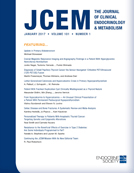-
Views
-
Cite
Cite
STEPHEN G. HILLIER, LEO E. REICHERT, EYLARD V. VAN HALL, Control of Preovulatory Follicular Estrogen Biosynthesis in the Human Ovary, The Journal of Clinical Endocrinology & Metabolism, Volume 52, Issue 5, 1 May 1981, Pages 847–856, https://doi.org/10.1210/jcem-52-5-847
Close - Share Icon Share
Abstract
Granulosa cells and follicular fluid were harvested from individual follicles at various stages of development during the midfollicular-early luteal phases of the cycle. Thirty-nine follicles between 5–28 mm diameter were studied. Granulosa cell estrogen synthetase (aromatase) activities were measured in vitro and related to corresponding follicular fluid levels of estrogen (l7βestradiol and estrone) and aromatase substrate (testosterone and androstenedione). The aromatase activity of thecal tissue from four dominant (22–28 mm in diameter) preovulatory follicles was also determined. 1) Granulosa cell aromatase activity and follicularfluid estrogen level were positively correlated (r =0.97) and were maximal in preovulatory follicles. 2) Granulosa cell aromatase activity and the follicular fluid aromatizable androgen to estrogen concentration ratio were negatively correlated (r =-0.97) and were lowest in preovulatory follicles. 3) Before the midcycle LH surge, all noncystic follicles had relatively constant follicular fluid aromatizable androgen levels, sufficient to drive the aromatase reaction rate of their granulosa cells maximally in vitro. 4) The single preovulatory follicle recovered during the LH surge had reduced follicular fluid levels of androgen and estrogen, although its granulosa cell aromatase activity remained maximalin vitro. 5) The uniformly low aromatase activity of granulosa cells recovered from nonovulatory follicles was occasionally stimulable by FSH in vitro. 6) Follicles yielding granulosa cells with a FSH responsive aromatase system were also present during the early luteal phase of the cycle. 7) In vitro, the aromatase activity of the granulosa cell layer was estimated to be at least 700 times higher than thatof the theca from estrogen secretory, preovulatory follicles.
It is concluded that the activity of the granulosa cell aroma-tase system, controlled by FSH, is a critical determinant of the intrafollicular sex steroid content of developing preovulatory follicles and that the granulosamay be the main biosynthetic source of estrogen in the dominant follicle.





